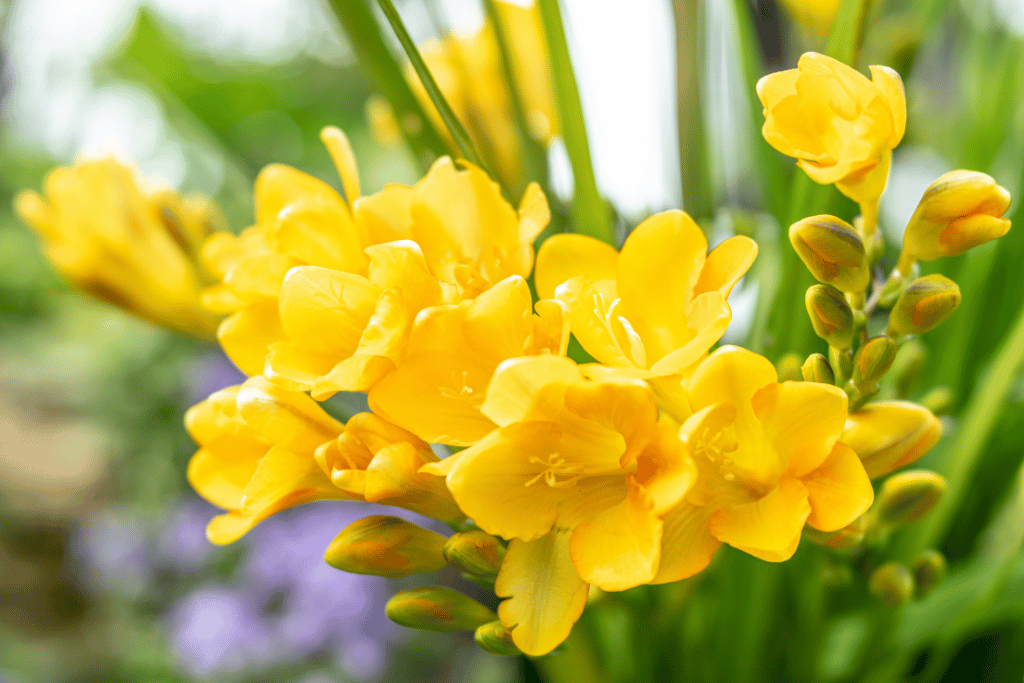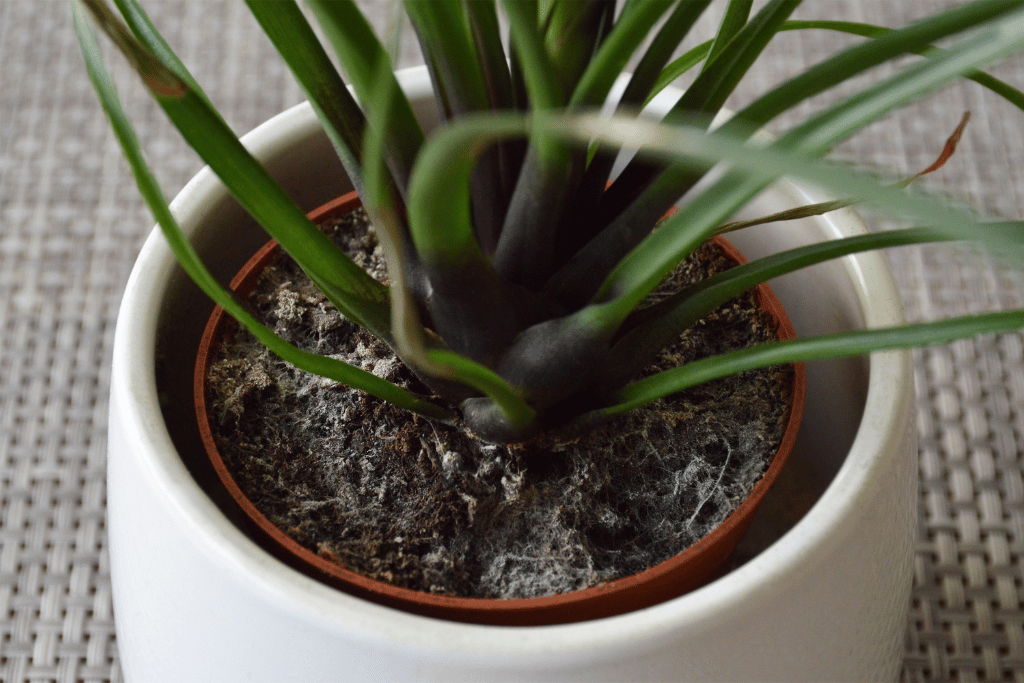
Are you tired of battling an enemy lurking in the soil of your beloved potted plants? Are you wondering why that pesky mold keeps showing up despite your best efforts to keep it at bay? Well, I can tell you it’s time to face the music and tackle the root of the problem: potted plant mold.
As a plant lover myself, I know the frustration of watching your once-beautiful potted plant wither away due to mold. It makes you wonder what you’ve done wrong and if you are a terrible plant parent.
I’m going to share with you everything you need to know about identifying and removing mold from potted plants. From the different types of mold to the health risks associated with it, we’ll cover it all!
So let’s get stuck into the nitty gritty of potted plant mold and learn how to take control of the situation. Because, let’s face it, we all want our potted plants to flourish and thrive, not wilt away.
Types of Potted Plant Mold
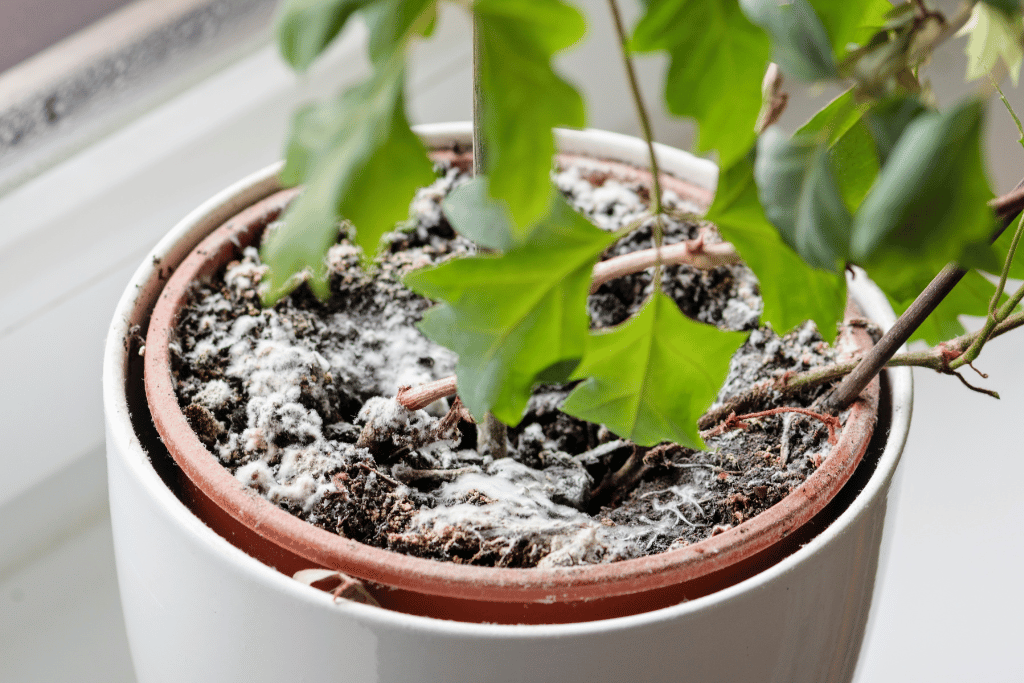
Potted plants can brighten up any room, but they can also harbor different types of mold that can ruin the aesthetic appeal of your indoor garden. Here are some of the most common types of mold that can grow in potted plants:
- Powdery Mildew: This type of mold looks like a white, powdery substance that can coat the leaves and stems of your plants. Its caused by fungal spores that thrive in humid conditions.
- Black Mold: As the name suggests, this type of mold appears as black spots or patches on the leaves, stems, or soil of your potted plants. It can be caused by overwatering or poor ventilation and can spread quickly if not addressed promptly.
- Gray Mold: This type of mold, also known as Botrytis cinerea, looks like a fuzzy gray coating on the leaves and stem of stems of your plants. It is caused by high humidity and poor air circulation and can quickly spread to nearby plants.
Several factors contribute to mold growth in potted plants, including over-watering, poor drainage, and lack of sunlight. Overwatering can create a moist environment perfect for mold and bacteria growth. Letting the soil dry out is essential before watering your plants again.
Another factor that can tribute to mold growth is poor drainage. If your plants sit in waterlogged soil, it can create a breeding ground for mold spores. So ensure your pots have drainage holes, and the excess water can drain away from the roots.
Finally, lack of sunlight can also contribute to mold growth. Sunlight helps to dry out the soil and prevent the growth of mold spores. So ıif you notice mold growing on your plants, try moving them to a sunnier location.
Signs of Mold in Potted Plants
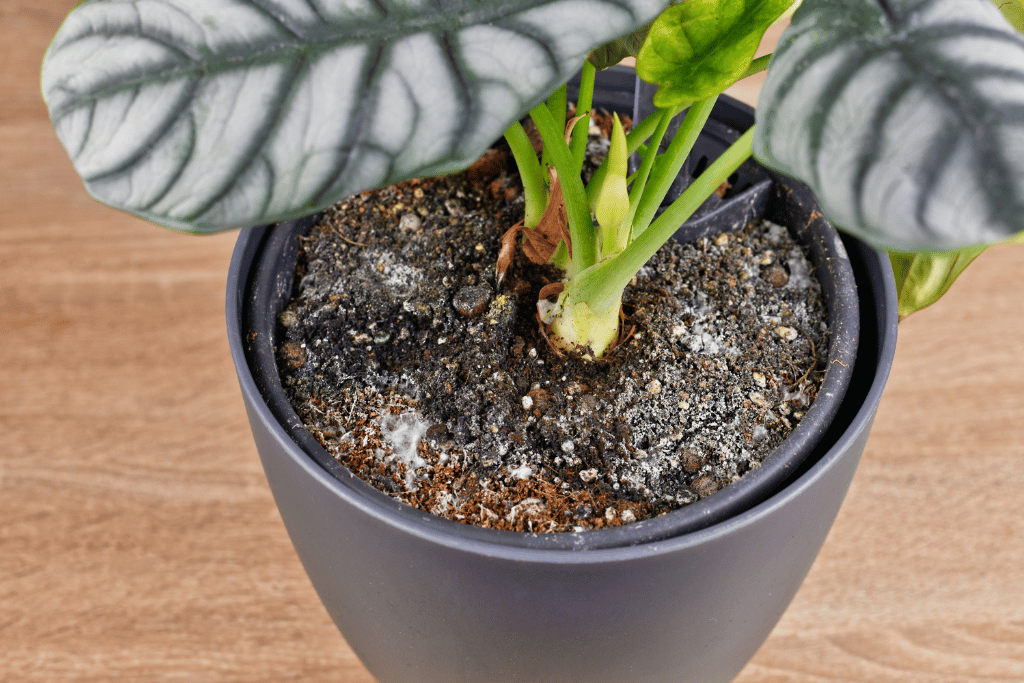
Mold can be a pesky problem for potted plant enthusiasts. It’s essential to keep an eye out for signs of mold in order to prevent it from spreading and damaging your plants.
Here are some common signs of mold in potted plants:
- Foul odor: Mold has a distinct, musty smell that can be a dead giveaway. If you notice an unpleasant odor coming from your potted plant, mold may have taken root.
- Discoloration: Mold can cause discoloration on the leaves and stems
- Soil appearance: Mold can also grow in the soil of potted plants. If you notice a white fuzzy substance on the soil’s surface, mold is likely present.
You can use a simple trick to identify mold in potted plant soil. Take a stick or a spoon and gently stir the soil. If you see a dust cloud rising from the soil, it could be a sign that mold is present. Another way to identify mold in potted plant soil is to look for any white or gray patches on the soil surface.
Symptoms of mold on potted plants can vary depending on the type of mold and the plant species. However, here are some general signs to look out for:
- Stunted growth: Mold can inhibit the growth of your plants and can cause them to appear stunted or underdeveloped.
- Wilting: Mold can cause the leaves of your plants to wilt or droop, even if they have been watered recently.
- Yellowing: Mold can cause the leaves of your plants to turn yellow, which is a sign of stress or disease.
Be sure to keep an eye out for signs of mold in potted plants; it’s an integral part of plant care.
By regularly inspecting your plants for mold and taking steps to prevent its growth, you can keep your indoor garden healthy and thriving.
Health Risks of Mold in Potted Plants
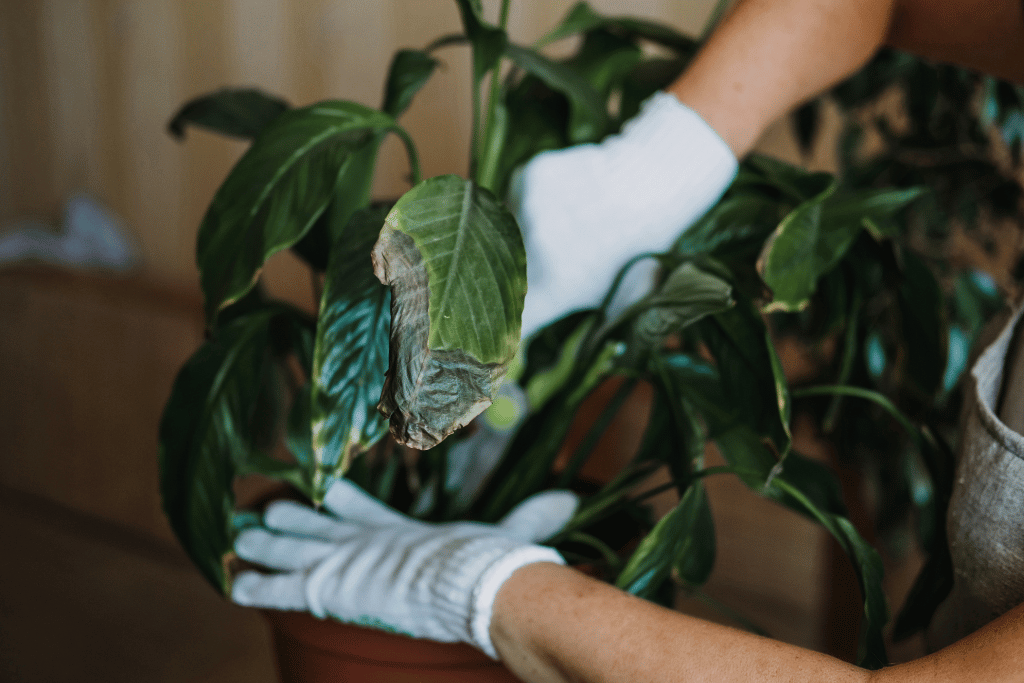
Moldy potted plants can pose a significant threat to your health. The fungus can grow on the soil, leaves, and even the pot itself, releasing spores that can cause various health problems, from mild allergies to more severe respiratory illnesses.
If you’re an avid plant lover and have noticed that some of your plants have become moldy, you may need to protect yourself from mold exposure. You should always wear gloves and a mask when handling moldy plants. Avoid touching your face or eyes after handling moldy soil or plants.
To prevent mold growth, ensure your plants are placed in areas with good ventilation and avoid over-watering them. It’s also a good idea to inspect your plants regularly for signs of mold and to remove any affected leaves or soil as soon as possible.
If you’re not careful, mold on potted plants can really grow on you. But don’t let it get the best of you! Remember, prevention is better than cure. So always take steps to protect yourself from mold exposure and keep your plants healthy and happy. After all, a moldy plant is no fun-gi for anyone!
I once had a beautiful peace lily that I kept in my bedroom. I loved the way it looked and the way it purified the air. But one day, I noticed that the soil was looking a bit moldy, and the leaves were starting to turn yellow. I tried to remove the moldy soil, but it had already spread to the roots, and the plant ended up dying. From that day on, I made sure to be more careful with my plants and to keep a closer eye on any signs of mold.
Preventing Mold in Potted Plants
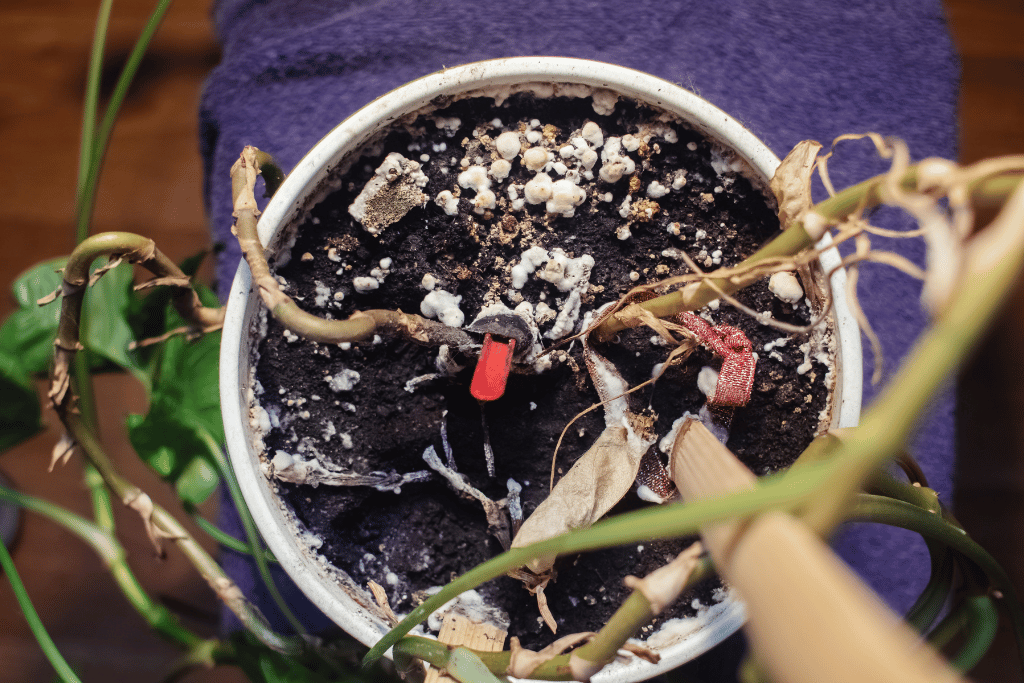
Moldy plants can be a real pain in the pot! But don’t stress; you can take plenty of steps to prevent mold growth and keep your plants healthy and happy. Here are some tips and best practices that have worked for me in the past:
- Choose suitable soil: Use well-draining soil that allows for proper airflow and water drainage. Avoid soil that retains moisture, as this can create the perfect breeding ground for mold.
- Water carefully: Overwatering is a major cause of mold growth in potted plants. Make sure you only water your plants when the soil is dry to the touch. Avoid watering from the top, as this can lead to soil becoming waterlogged and, instead, water from the bottom.
- Increase air circulation: Mold thrives in stagnant, moist air. To prevent mold growth, ensure your plants are in a well-ventilated area with plenty of fresh air.
- Avoid overcrowding: Don’t cram too many plants into a small space, as this can increase humidity and create an environment that’s perfect for mold growth.
- Keep it clean: Regularly clean your pots and remove any dead leaves or debris that may be present in the soil. This will help prevent mold from taking hold.
- Use natural remedies: Consider using natural remedies to prevent mold growth, such as adding cinnamon powder or vinegar to the soil. These natural remedies can help prevent mold spores from taking root.
I once had a small herb garden in my kitchen that kept developing mold on the soil’s surface. I soon realized I had been overwatering the plants and not allowing proper air circulation. Once I adjusted my watering schedule and moved the plants to a sunnier spot with better airflow, the mold disappeared, and my plants started to thrive.
How to Remove Mold from Potted Plant Soil
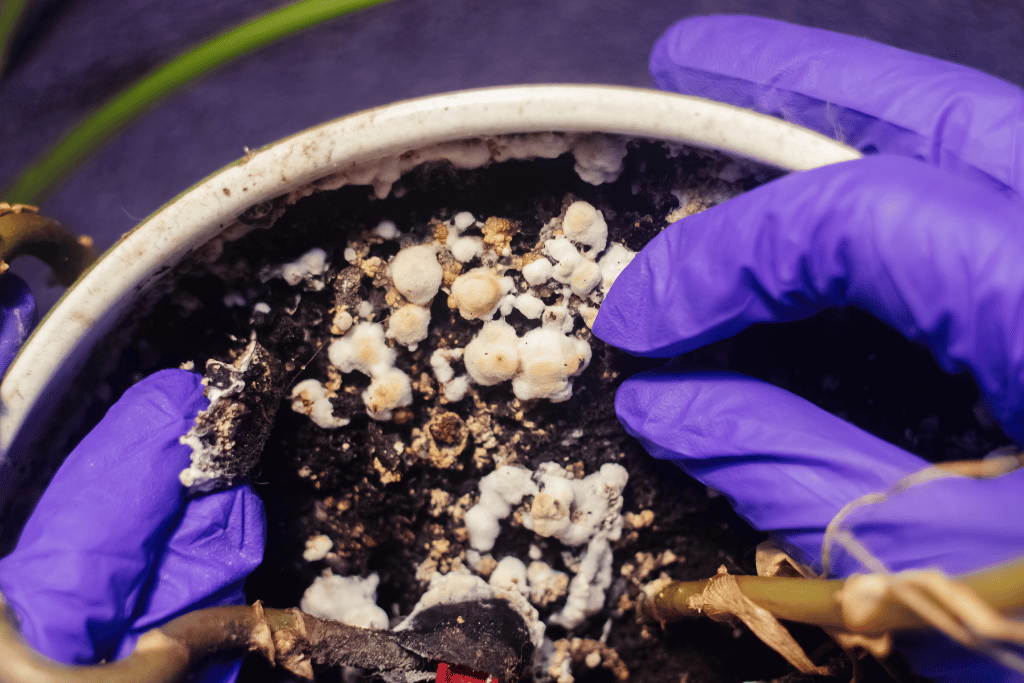
So now you know how to detect mold on your potted plants and how to prevent it. Here’s a simple rundown on how to get rid of mold on potted plant soil:
You’ll need a few items to begin with:
Tools:
- Gloves
- A face mask
- A spray bottle
- A trowel or small gardening shovel
- A large plastic bag
Materials:
- Distilled white vinegar
- Water
- Hydrogen peroxide (optional)
- New potting soil (optional)
Step-by-step instructions:
- Put on gloves and a face mask to protect yourself from mold spores
- Remove any dead leaves or plant debris from the soil surface
- Mix one part of distilled white vinegar with three parts of water in a spray bottle.
- Spray the mixture onto the moldy areas of the soil until they are saturated. Allow the mixture to sit for about 10-15 minutes.
- Use a trowel or small gardening shovel to scrape off the moldy soil and dispose of it in a large plastic bag.
- If there is still visible mold, you can use hydrogen peroxide mixed with water (one part hydrogen peroxide to nine parts water) to spray the affected areas. Allow the mixture to sit for 10 minutes before wiping it away with a clean cloth. Once you’ve removed as much mold as possible, allow the soil to dry out completely before adding new potting soil.
- If the plant is severely affected by mold, consider repotting it with fresh potting soil to prevent the mold from returning.
- After repotting, water the plant as usual, being careful not to overwater.
Following these steps will safely remove the mold from the potted plant soil and keep your plants healthy.
Keeping your Plants Mold Free: The Key to Healthy Indoor Gardening
Overall, mold can be a severe problem for potted plants, leading to poor plant health and even death. However, with proper care, you can prevent mold from growing in the first place and remove it if it does appear.
Using simple tools and materials like vinegar and hydrogen peroxide, you can effectively clean mold from potted plant soil and keep your plants healthy.
Remember to wear protective gear when dealing with mold and allow the soil to dry out completely before adding new potting soil. With these steps, you can enjoy a mold-free indoor garden that flourishes all year round.
Ready to Get Your Hands Dirty?
Don’t let your plants bite the dust. It’s time to get your hands dirty and give your plants the love and care they deserve.
Head over to our planting pages, where you’ll find all the much-needed advice on how to keep your garden looking sleek.
We enjoy sharing our plant knowledge with you, so whether you’re a total beginner or have been gardening for a while, you’re sure to find some useful planting tips and tricks.
So what are you waiting for? Grab the bull by the horns and show all your friends how much you know about plants.



